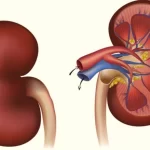Polycystic kidney disease
Polycystic renal disorder (Polycystic kidney disease) is the most prevalent disease among hereditary kidney diseases. the most effective of this disease is on the kidney. an outsized number of cysts (water filled bubble) form in both the kidneys. The Polycystic renal disorder is additionally one of the most causes of chronic renal failure. aside from the kidney, such cysts also are seen in many patients within the liver, spleen, sputum, and brain tube. (Polycystic kidney disease) Women, men, and other people of various castes and countries are equivalent.
The spread of the Polycystic kidney disease
An estimated one in 1000 people have this disease.
Kidney disease patients who require dialysis or kidney transplant, 5% of them have a disease called polycystic renal disorder (Polycystic kidney disease).
Hereditary patient
Polycystic renal disorder in adults may be a genetic disease of the autosomal dominant type, during which 50 percent of the patient, half the entire children are likely to urge the disease.
Family members check
(PK) The patient’s brother, sister, and youngsters should be examined for (Polycystic kidney disease). aside from this, the siblings of his parents, who have inherited this disease from the patient, should even be examined.
Difficulties to prevent
Normally when diagnosed (Polycystic kidney disease), the age of the patient is around 35 to 55 years. In most (PKD) patients, children are born before they reach this age. For this reason, it’s impossible to stop (Polycystic kidney disease) from being in future generations.
Polycystic kidney disease Kidney effect
(Polycystic kidney disease) Innumerable cysts like balloons or bubbles are found in both kidneys.
Of the various cysts of diverse sizes, the dimensions of the smaller cyst are so small that it’s impossible to ascertain the cyst with the eye and therefore the size of the larger cyst could also be quite ten (cm) in diameter.
- Over time, the dimensions of those small big cysts start increasing, thanks to which the dimensions of the kidney also increases.
- In this way, increasing cysts bring pressure on the working parts of the kidney, which results in high vital sign. And kidney function is progressively reduced.
- In this disease, chronic renal failure occurs after a few years and therefore the patient progresses to severe renal failure (end-stage kidney disease). Finally, dialysis and kidney transplant are required.
- Kidney diseases (PKD) are the foremost common diseases.
Polycystic kidney disease Symptoms
Generally, no symptoms are seen in patients between 30 and 40 years aged. The symptoms seen then are as follows:
- Increased vital sign.
- Abdominal pain, abdominal distension, abdominal enlargement.
- Bleeding within the urine.
- Frequent urination infections.
- Kidney stones
- As the disease progresses, symptoms of chronic renal failure also begin to seem.
- Increased likelihood of kidney cancer.
Cysts like kidneys also can occur in other parts of the body just like the brain, liver, intestines, etc. For this reason, symptoms also can appear in those organs. A patient with polycystic renal disorder may have complications like aneurysm (cerebral artery enlargement), hernia within the wall, infection within the liver cyst, diverticula within the abdomen, or hole and malfunction of the guts valve.
Approximately 10% of patients with the polycystic renal disorder may have arterial eruptions (aneurysms), during which there’s a bulge within the vessel wall thanks to its weakening. Headache may occur thanks to arterial dilation. Its rupture is often dangerous, which may cause stroke and death.
The main symptoms of a 40-year-old (PKD) are stomach lump and blood within the urine.
Kidney failure of the treated patient
Not all patients diagnosed with (Polycystic kidney disease) have poor kidney function. (Polycystic kidney disease) the amount of renal failure patients is 50 percent at the age of 60 years and 60 percent at the age of 70 years. the danger of chronic renal failure in patients with a polycystic renal disorder is higher within the male population, the high vital sign at an early age, protein or bleeding within the urine, or in those with an outsized kidney.
The diagnosis
Kidney Sonography:
- P.K. with the assistance of sonography Diagnosis of D. is definitely through with less expense.
- CT Scan:
- (Polycystic kidney disease) If the dimensions of the cyst are extremely small, it’s not caught by sonography. Early diagnosis of this stage (PKD) is often made by a CT scan.
- Family History:
- If any loved one (PKD) is diagnosed, then there’s an opportunity of other members of the family (Polycystic kidney disease).
- Urine and blood test:
- Urine test: to understand urinary infections and blood volume.
- Blood test: the quantity of urea, creatinine within the blood is understood to understand the functionality of the kidney.
- Pk D. thanks to genetic disease, it’s necessary to urge the patient’s relations examined.
Genetic Testing:
The structure of the body is decided by genes, ie, chromosomes. thanks to a scarcity of some chromosomes (Polycystic kidney disease). within the future, the presence of those chromosomes is going to be diagnosed with special sorts of tests, so that it’s possible to understand whether there’s an opportunity of disease (PKD) even during a youth.
Decreased renal failure
(PKD) maybe a genetic disease, which at this point there’s no treatment available to eradicate or prevent it.
(PKD) maybe a genetic disease. If one among the relations has PK As soon as D. is diagnosed, consistent with the recommendation of the doctor, it’s important to understand from the examination of sonography that other members don’t have this disease.
The treatment of Polycystic kidney disease
Why is it necessary to treat this disease?
Yes, even after treatment, the disease isn’t curable. Nevertheless, treatment of this disease is important, because by taking the required treatment, the damage to the kidney is often avoided, and therefore the speed of renal failure is often limited. renal failure is often prevented or slowed if there are early diagnosis and proper treatment of hypertension during a (PKD) patient. (PKD) If the patient revises his lifestyle and diet, he protects his heart and kidney. a serious disadvantage of screening is that the patient becomes more agitated about his illness, at a time when the person neither shows any symptoms nor needs any treatment.
- (Polycystic kidney disease) the earlier the diagnosis is formed, the greater the advantage of treatment.
- Main treatment
- (PKD) patients are advised to be periodically examined and monitored. albeit they are doing not need any quite treatment.
- Always keep a high vital sign in check.
- Urgent treatment as soon as tract infection and appendicitis occur.
- If there’s no swelling on the body, such a patient should drink a lot of water, which helps in reducing the matter of infection, stones, etc.
- Abdominal pain should be treated with special medicines that don’t harm the kidneys.
- In the case of renal failure, it’s necessary to avoid and take treatment as discussed during this section.
- Very few patients require surgical or radiological drainage of the cyst thanks to pain, bleeding, infection, or any obstruction.






